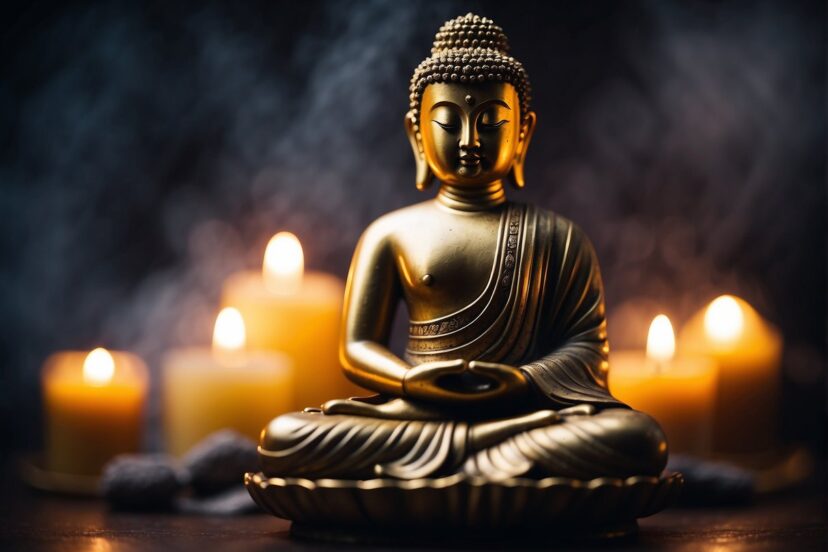Meditating Buddha: Essence of Serene Enlightenment
*We may earn a commission for purchases made using our links. Please see our disclosure to learn more.
Meditating Buddha: Unveiling the Essence of Serene Enlightenment
Meditating Buddha refers to both the representation of the historical Buddha in a meditative pose and the practice of meditation within the Buddhist tradition. Meditation in Buddhism is aimed at developing the mind, achieving a serene state of consciousness, and ultimately leading to spiritual liberation. The classical languages of Buddhism describe meditation using terms like bhāvanā, which signifies mental development, and jhāna/dhyāna, indicative of mental training that leads to tranquility and clarity.

I understand that Buddhist meditation is not just a spiritual exercise but a methodical practice that includes a variety of techniques to cultivate mindfulness, concentration, and insight. This tradition, as taught by the Buddha, emphasizes the importance of being mindful of four key aspects: the body, feelings, mind, and phenomena. The goal is to observe these elements with detachment, recognizing transient nature and fostering a non-attached awareness.
One of the most significant moments in the life of the historical Buddha was the night of his enlightenment, which is often depicted in the seated Meditating Buddha posture. This event signifies the culmination of the Buddha’s quest for understanding, as he meditated deeply and overcame the temptations and fears that marred the path to true awakening. The seated posture of the Buddha in meditation, therefore, is not only iconic of the figure himself but also embodies the essence of the practice that leads to enlightenment.
Understanding Meditation
In my exploration of meditation, I’ve found it to be a multifaceted practice essential for cultivating mental clarity and emotional stability. This section aims to demystify the core principles and varied techniques within the practice.
Meditation Fundamentals and using a Meditating Buddha
My experience with meditation suggests it creates a space for the mind to become quiet, fostering an environment where focus and concentration can thrive. At its core, meditation is the practice of training one’s mind to achieve a state of peaceful awareness. Mindfulness is a fundamental aspect of meditation, which involves being fully present and aware of our thoughts, feelings, bodily sensations, and the surrounding environment.
- Focus: Central to meditation is the cultivation of focus, directing the mind to a single point of reference.
- Peace: The practice seeks to establish a sense of peace, reducing the noise of everyday life to attain mental tranquility.
Types of Meditation
Various types of meditation have evolved from ancient traditions, with each targeting different aspects of consciousness.
- Vipassana (Insight Meditation)
- Vipassana emphasizes self-observation, aiming to understand the true nature of reality. It enhances mindfulness by observing thoughts and sensations without attachment.
- Shamatha (Tranquil Abiding)
- This form of meditation focuses on developing concentration through sustained attention on a single object, leading to a state of calm.
- Dhyana (Zen Meditation)
- In Zen practice, meditation often involves sitting quietly, observing the breath, and allowing thoughts to pass without judgment, which can lead to profound states of insight and stillness.
By understanding the foundational principles and the diverse practices available, individuals can find the path of meditation that best aligns with their needs and intentions.
The Buddha’s Influence

The Buddha’s teachings have shaped the spirituality and philosophies of countless individuals and societies over millennia. My focus here is on the foundational Buddhist concepts introduced by the Buddha and their historical evolution across different cultures and schools of Buddhism.
Buddhist Concepts
The core of Buddhism revolves around key teachings attributed to Siddhartha Gautama, known as the Buddha after his enlightenment. Central to these teachings is the concept of the Four Noble Truths, which are foundational to all schools of Buddhism. They comprise the truth of suffering (dukkha), the cause of suffering (craving), the end of suffering (nirvana), and the path leading to the end of suffering (Eightfold Path).
Mindfulness (sati) and meditation are pivotal practices in Buddhism, serving to develop concentration, clarity, emotional positivity, and a calm seeing of the true nature of things. Mindfulness, in particular, has transcended Buddhist practice and entered mainstream psychological therapies.
My examination also brings attention to the different paths within Buddhism that emphasize various aspects of the Buddha’s teachings. Theravada, often considered the oldest school, focuses on wisdom and meditation, while Tibetan Buddhism incorporates esoteric elements and rituals. Chan, or Zen, a school prominent in East Asia, stresses the direct realization of enlightenment. Additionally, Pure Land Buddhism emphasizes faith in and devotion to Buddha Amitabha for achieving rebirth in the Pure Land, a celestial realm where enlightenment is ensured.
Historical Context
Historically, Buddhism has proven adaptable, molding to the cultures it encountered as it spread from India throughout Asia and, eventually, to the West. This adaptability is seen in the formation of various schools and traditions like Theravada, Mahayana, and Vajrayana.
The monastic community (Sangha), established by the Buddha, has served as the guardian of Buddhist teachings (the Dharma) and has been a conduit for Buddhist teaching and meditation practices for laypeople. The Theravada tradition, which prevails in Sri Lanka and Southeast Asia, upholds the original teachings of the Buddha contained in the Pali Canon.
In contrast, Tibetan Buddhism, found primarily in Tibet, Bhutan, and Mongolia, incorporates a comprehensive system of meditation and tantric rituals. Nor can we discuss the historical impact of the Buddha without mentioning the profound influence of Buddhist meditation techniques, which have culminated today in a widespread appreciation of mindfulness practices, once unique to Buddhism, in enhancing mental well-being.
Practical Meditation Guidelines and using a Meditating Buddha

In practicing meditation, it’s crucial that I pay close attention to my posture and the space around me, as well as the techniques I employ for breathing and focus. These factors directly influence the quality of my meditation session.
Posture and Environment when using a Meditating Buddha
When I sit down to meditate, ensuring proper posture is essential. I begin by finding a quiet place that minimizes distractions. Here’s my checklist for setting up the environment and posture:
- Quiet Place: A location where interruptions are minimal.
- Meditation Posture: Whether on a cushion or chair, I keep my spine straight but not rigid.
| Posture Component | Specification |
| Spine | Straight and upright |
| Hands | Resting on lap or knees |
| Eyes | Closed or Downcast softly |
| Legs | Cross-legged or comfortably if on a chair |
Creating an environment conducive to meditation enhances my ability to maintain focus and concentration. A well-set environment also helps in building a routine and associating the practice with a feeling of calm and relaxation.
Breathing and Focus Techniques
Breathing is central to my practice of mindfulness. I start by taking a few deep breaths, noticing the rise and fall of my abdomen. Then, I allow my breathing to return to its natural rhythm, engaging in anapanasati, or mindfulness of breathing.
| Breathing Aspect | Focus Point |
| In-breath | Sensation of air entering the nostrils |
| Out-breath | Sensations of air exiting |
| Abdomen | Movement with each breath |
As thoughts arise, I gently redirect my attention back to my breath, fostering a sense of awareness without judgment. It’s normal for my mind to wander, but with gentle guidance, I can cultivate a steady energy that fuels my progress in meditation. My goal is to maintain a balance between relaxation and alertness, establishing a sustained concentration that can deepen into meditative awareness.
The Psychological Benefits of Meditation with a Meditating Buddha

Meditating as Buddha did, I find, cultivates profound transformation in psychological well-being. Through dedicated practice, I’ve noticed enhancements in emotional equilibrium and cognitive sharpness, reflecting the spectrum of benefits meditation offers.
Emotional Well-being
My journey into meditation has shown me the tangible impact it has on regulating emotions. Studies have demonstrated, and I can attest, that regular meditation reduces stress, eases anxiety, and diminishes symptoms of depression. By fostering mindfulness, meditation enables me to observe my feelings without becoming entangled in them. This detachment builds emotional resilience and promotes a sense of tranquility and well-being, allowing happiness and compassion to flourish.
- Stress Reduction: Steady practice lowers cortisol levels, the body’s stress hormone.
- Enhanced Equanimity: Achieving a state of equanimity helps in maintaining calmness in stressful situations.
- Fostering Compassion: Meditation nurtures love and compassion, improving relationships and societal bonds.
Cognitive Improvements
Meditation enhances my cognition in various ways. I’ve gained increased clarity and awareness of my mental processes, leading to sharper decision-making and improved problem-solving abilities. Furthermore, by promoting mindfulness, I’ve enhanced my concentration and attention span, which in turn boosts productivity and performance in various tasks. Regular meditation also contributes to the attainment of spiritual awakening, often described as an awakening or liberation of the mind, providing a profound sense of freedom and expanded consciousness.
- Clarity and Focus: Continuous practice clears the mind, resulting in improved focus and mental clarity.
- Memory Recall: Positive changes in brain structure from meditation may enhance memory and recall abilities.
- Psychological Flexibility: Meditation helps in developing an adaptable mind capable of better handling new situations.
Integrating Meditation into Life with a Meditating Buddha
To seamlessly incorporate meditation into everyday routines, it’s essential to understand both the practical strategies and long-term benefits. Let’s explore how to establish a consistent practice and what changes may unfold as meditation becomes integral to life.
Daily Practice and Challenges
In my experience, integrating meditation into daily life begins with setting a clear intention. It’s about carving out time amid busy schedules for mindfulness or vipassana meditation. I have found success in assigning specific times for practice, often early in the morning or just before sleep, to create a routine. However, challenges are part of the process. Resistance can come in many forms, from sensual desire to worry. Here’s a strategy I employ:
- Scheduling: I reserve a slot in my day solely for meditation, treating it with the same priority as any important appointment.
- Environmental Cues: I set up a dedicated space that, when I see it, reminds me to pause for mindfulness or mantra repetition.
- Incremental Progress: I start with short sessions, perhaps five minutes, and gradually increase the duration as my concentration improves.
- Guided Sessions: Initially, I use guided meditations to learn proper technique and for motivation.
Long-Term Effects and Lifestyle
Over time, I’ve observed numerous benefits. Consistent meditation has facilitated positive change in my disposition, promoting kindness and compassion within my interactions. I also notice a heightened awareness of reality which seems to slow down the perception of aging, aligning with Buddhist teachings. Here are some specific long-term effects:
- Emotional Resilience: Challenges in life become less daunting as I develop a non-reactive mindset.
- Improved Focus: Regular meditation enhances my concentration, aiding in all aspects of daily life from work to interpersonal relationships.
- Lifestyle Choices: With increased mindfulness, I make healthier choices, mitigating the pull of sensory pleasures.
Through these practices, sourced from ancient Pali texts, and influenced by cultural adaptations in places like Japan and China, I’ve woven meditation into the fabric of my life. Whether it be through silent meditation, utilizing mantras, or immersing in meditation music, the key is consistency and adapting techniques that resonate with my personal journey.
Meditating Buddha FAQ’s
In my experience with Buddhist art and symbolism, people often have questions about how these serene figures fit into their spaces and lives. Here, I’ll answer some common inquiries about Meditating Buddha statues.
1. How can a Meditating Buddha statue influence home decor aesthetics?
A Meditating Buddha statue brings a sense of tranquility and mindfulness to any room. Its presence can create a focal point that embodies peace and can inspire a calming interior design theme throughout the space.
2. What are the meanings behind different materials used in Buddha statues, like metal or ceramic?
The materials in Buddha statues carry distinct energies and interpretations. Metal statues, often made of bronze or brass, signify strength and durability, while ceramic figures convey delicacy and a grounded nature, interpreted as a representation of the Buddha’s earthly journey.
3. What is the significance of Shakyamuni Buddha in the context of Buddhist statues?
Shakyamuni Buddha, recognized as the historical Buddha, is often depicted in meditation reflecting his enlightened state. Statues of Shakyamuni Buddha serve as a reminder of the potential for enlightenment that lies within all beings.
4. How does the Zen Buddha statue represent principles of Zen Buddhism?
Zen Buddha statues are minimalist and reflect the simplicity and directness of Zen Buddhism. They often portray the Buddha in meditation, emphasizing the importance of zazen, or seated meditation, as a means to self-realization and present-moment awareness.
5. What is the symbolism of the ‘Happy Buddha’ and how does it differ from more traditional Buddha representations?
The ‘Happy Buddha’ is actually a depiction of Budai, a Chinese monk, symbolizing contentment and abundance. This contrasts with the more austere representations of the historical Buddha, which emphasize the noble path and the pursuit of enlightenment.




